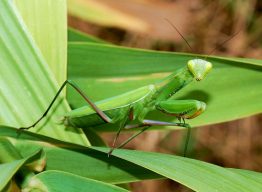Praying Mantis
 Order: Mantodea
Order: Mantodea
Family: Mantidae
How to identify:
As with most insects, mantises have six legs and four wings. Praying mantises can be identified by their slender bodies and large, bent front legs. They are usually green or brown, and adults can range from 2-5 inches, depending on sex and species.
Advanced ID: The praying mantis can be identified by its elongated prothorax and raptorial forelegs. They have a triangular head with large compound eyes. The females are larger and have longer cerci on their abdomen (Borror & White, 1998).
Ecology
Metamorphosis Type: Simple metamorphosis
Geographic Range: Found on every continent except Antarctica.
Habitat: Most are found in grasslands and forests, but can be found even in backyards, meadows, shrublands or deserts.
Trophic Level: Predator
Food: Praying mantises catch their food with their raptorial forelegs, a specialized bent leg that is useful for grasping prey. (Waleed, 2021) They utilize camouflage to blend in with their environment, and they wait for prey to cross their path (e.g., often on or near a flower). They are generalists and will feed on almost anything they can catch- mostly other insects (including other praying mantises), but occasionally small birds (like hummingbirds), reptiles, and mammals.
Why should we care?
Human Uses: In the past, people have introduced non-native mantis species in the hope that they would eat pest insects that damage human crops. However, mantises are indiscriminate predators and eat whatever they can catch, resulting in them consuming not just harmful pest insects, but also beneficial ones. In New Jersey, there are three species of mantis- the native Carolina mantis (Stagmomantis carolina), the introduced Chinese mantis (Tenodera sinensis), and the introduced European mantis (Mantis religiosa). (Pyle 2020)
The Carolina mantis can be identified by its smaller size (2-3 in) and brown coloration. (Neff 2019) The Chinese Mantis is much larger and has a green stripe along its wings. The European Mantis can be identified by its red and white stripes along its wings.
Conservation Status: Most mantises are considered least concerned on the IUCN red list. (Battison 2015)
Did you know?
- To some people, the bent front legs of the mantids appear as though they are praying.
- Praying Mantises are the only insect known to be capable of turning their heads 180 degrees. (The Buzz)
Images Cited
Photo 1: Alvesgaspar. 2007. Creative Commons License | Link
Photo 2: Carolyn Hietala. 2006. Creative Commons License | Link
Photo 3: Hans Hillewaert. 2008. Creative Commons License | Link
Photo 4: Ziva & Amir. 2014. Creative Commons License | Link
Photo 5: Toshiyuki IMAI. 2006. Creative Commons License | Link
Researcher’s Biography
Chris Delvecchio
Completed this research within Dr. Shelly Thomas’ Entomology course
Suggested Citation:
Delvecchio, Chris (2021). Praying Mantis. Rowan University Arboretum. https://arboretum.rowan.edu/learn/explore-insects/praying-mantis/
Questions to Explore
- How do praying mantises contribute to the regulation of insect populations in agricultural and natural ecosystems?
- Are praying mantises beneficial insects overall, or do they also have negative impacts on other species?
- How do praying mantises use their senses (sight, touch, etc.) to navigate their environment and hunt prey?
- How can research findings on praying mantises be applied to improve pest control, conservation efforts, or technologies such as drones?
- How have Native American artists incorporate praying mantis imagery into their art, and what is the significance of these depictions?
- How do Native American perspectives on praying mantises differ from Western scientific views on their biology, behavior, and ecological role?
Citations
Borror, D. J., & White, R. E. (1998). A field guide to the insects of America north of Mexico, 2nd edition. Boston: Houghton Mifflin Harcourt.
The Buzz. Five fast facts about easy-to-miss praying mantises. (n.d.). Accelerator. Retrieved December 5, 2023 | Link





